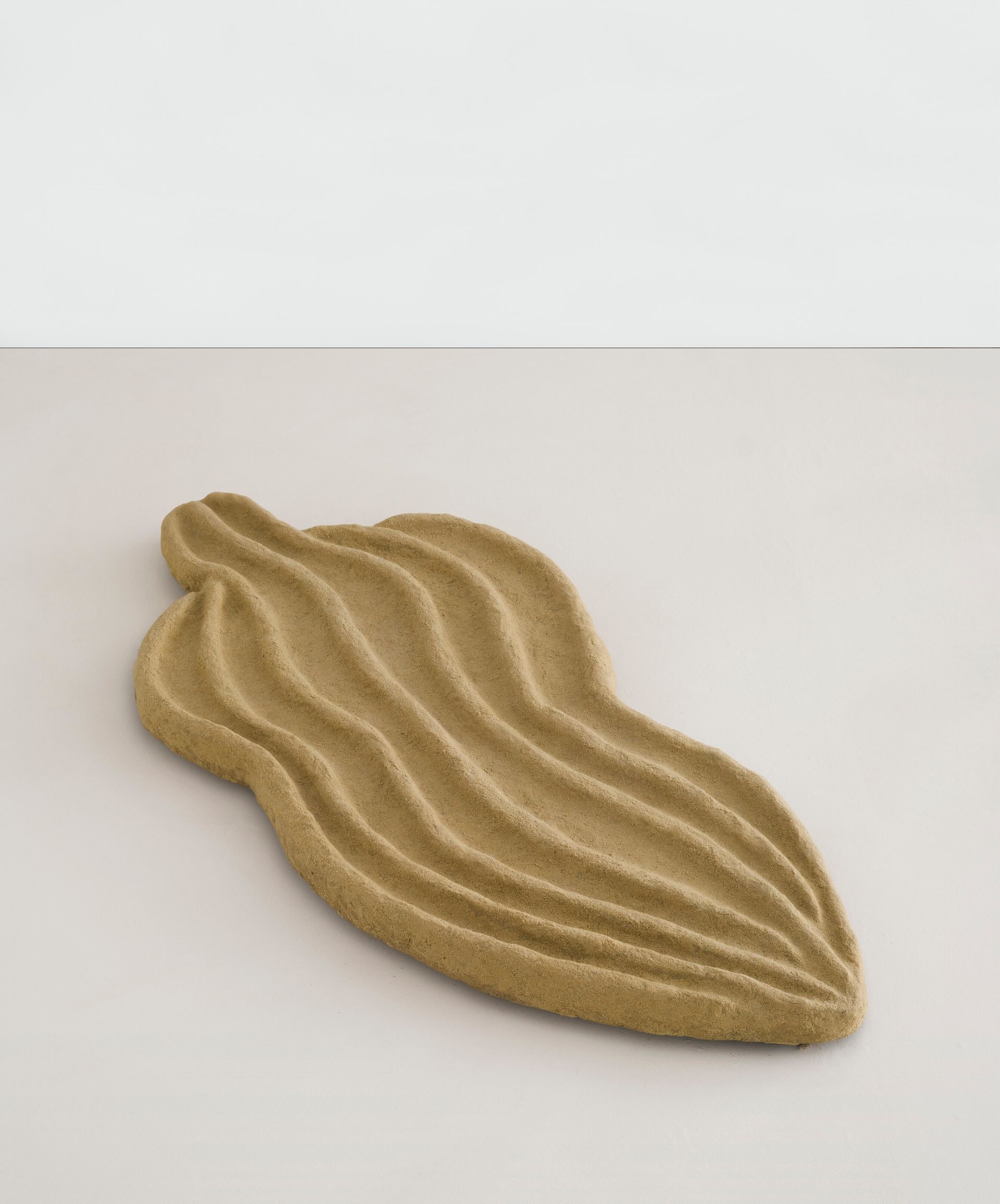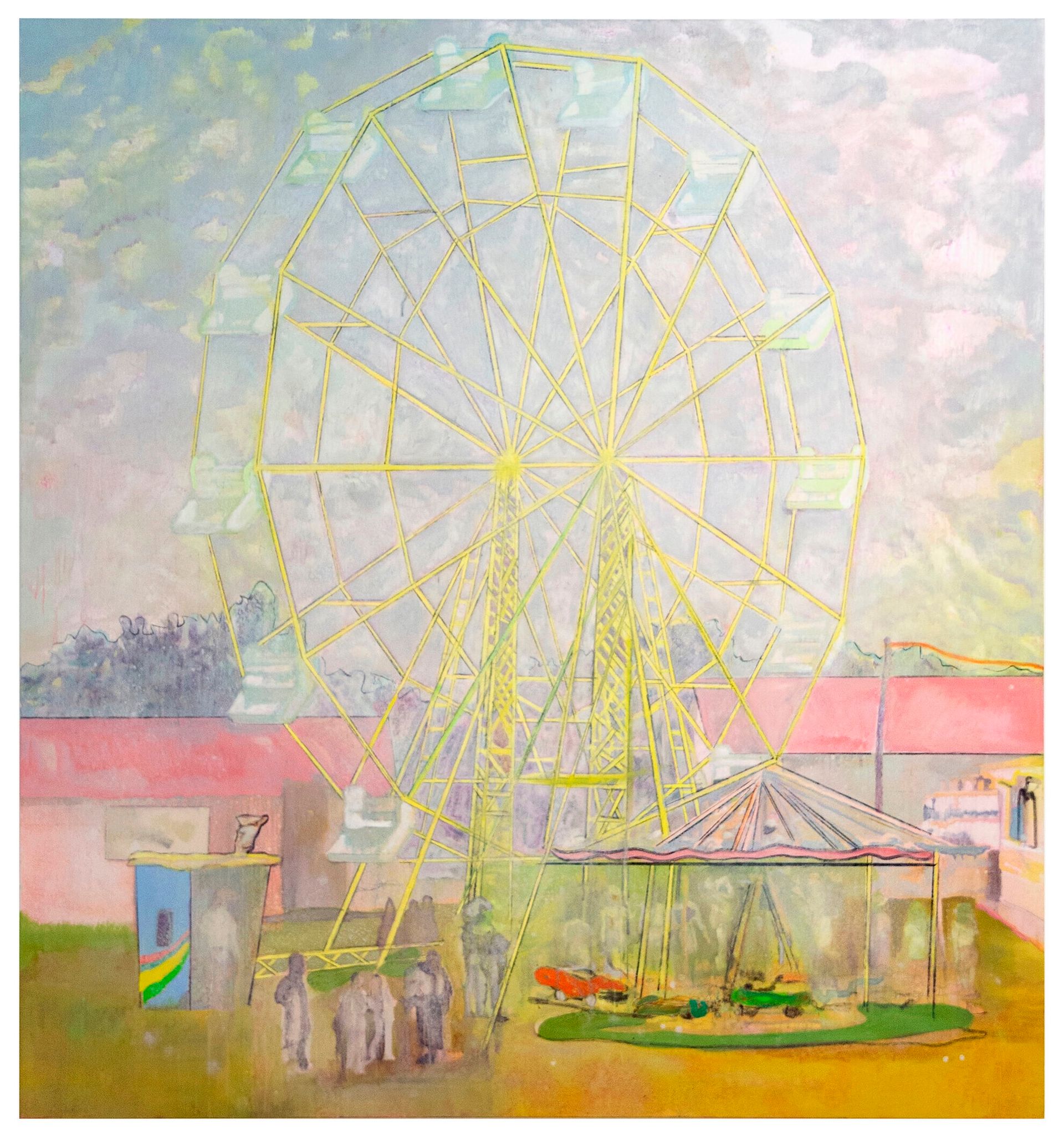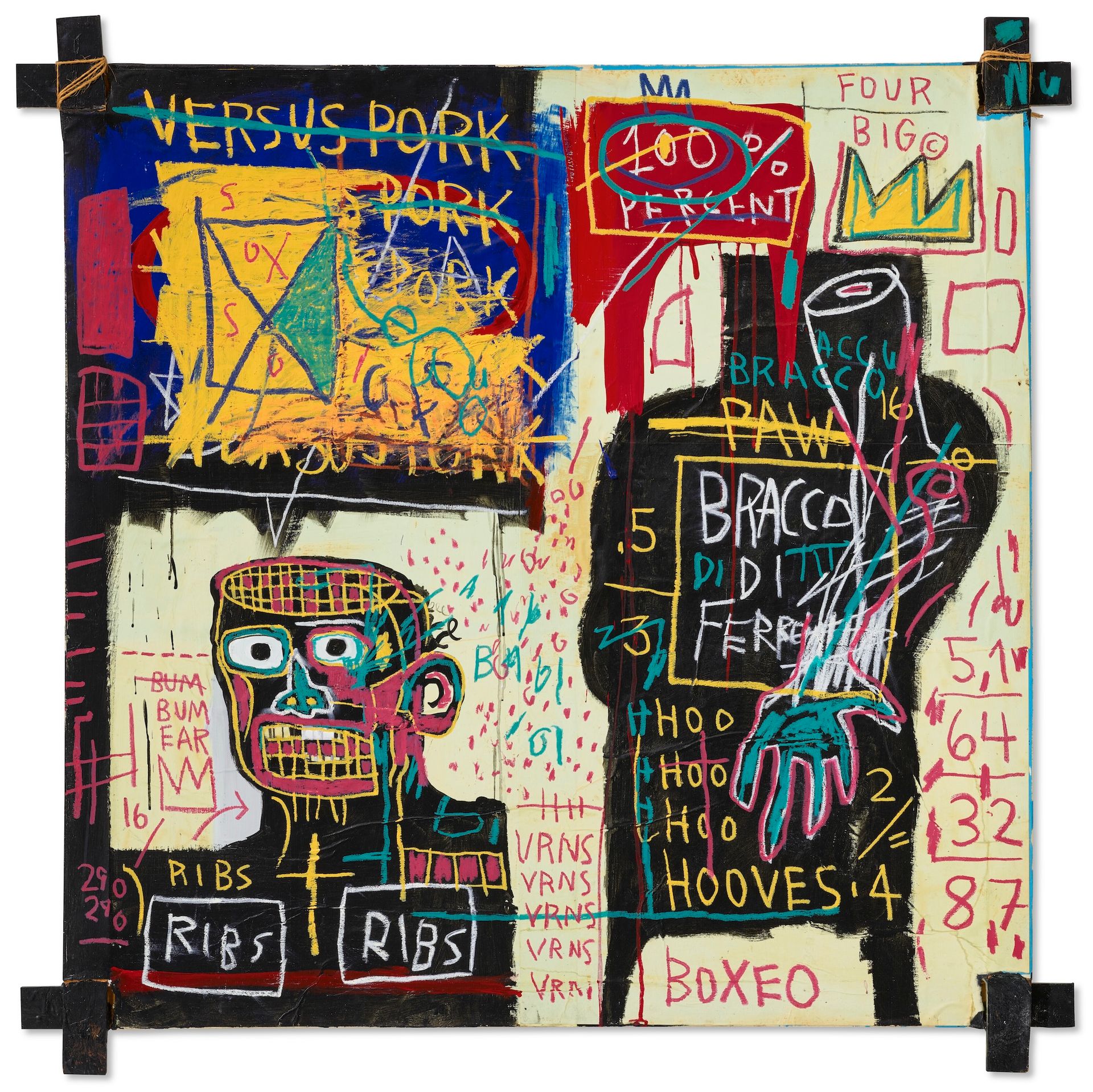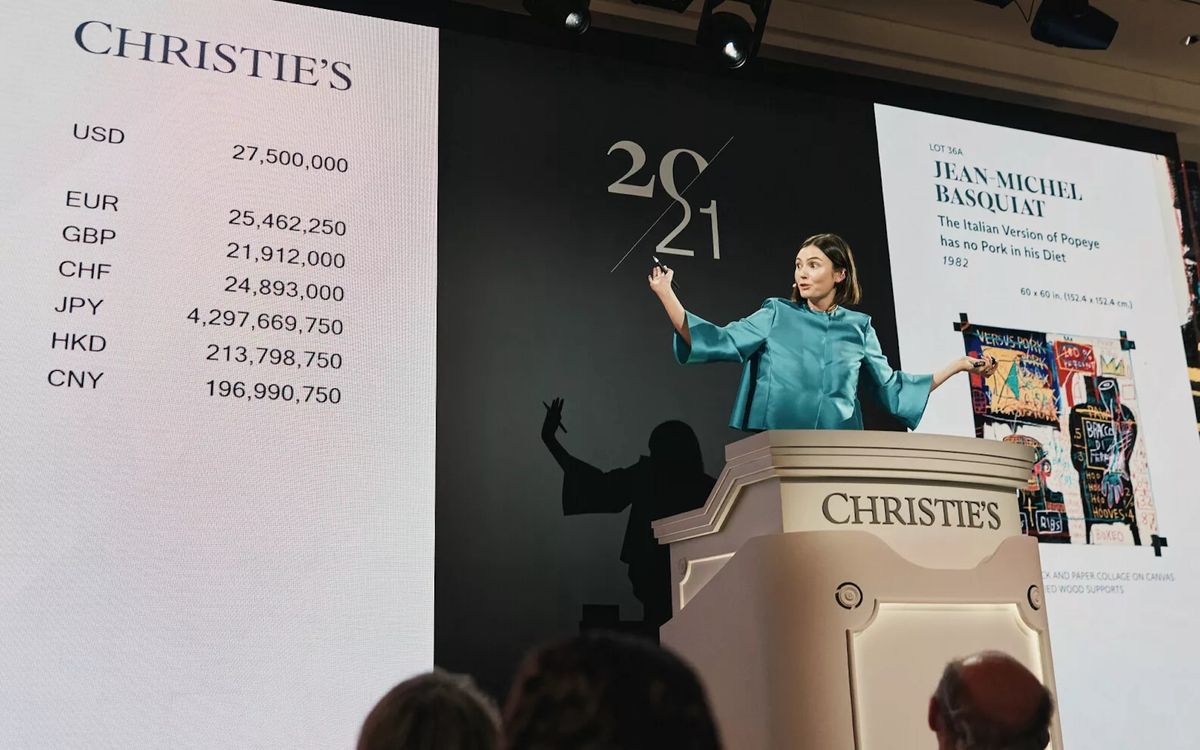Christie’s showed tremendous resilience through an up-and-down pair of evening sales held back-to-back in New York on Tuesday night (14 May). Although one major disappointment cast a long shadow over the final figures, some reasons for optimism and pride were nevertheless visible throughout the night.
First was a dedicated auction of 26 works from the collection of the late Miami-based collector Rosa de la Cruz and her husband, Carlos. Although Christie’s secured around 100 pieces from the trove in all, the majority will be parceled out across various sales throughout the remainder of 2024. The second component was the 21st-century evening sale, the house’s latest offering of works largely made between the 1980s and the present day.
Together, the two sales brought a hammer total of $94.6m ($114.7m with fees), against a presale target range of $130.6m to $192.9m (calculated without fees). Six of the 61 lots were withdrawn, eliminating at least $34.7m from Christie’s potential sale proceeds based on the low estimates.
And yet, counting the six withdrawals, the sell-through rate for the evening was a healthy 90% by volume. Bidding was lively throughout the double-header—all the more noteworthy given that many in the trade expected the De la Cruz offerings to underwhelm based on the market’s mood and the chatter that several of the artists in the late collector’s holdings had fallen out of fashion. Even if that were the case, however, it appears that Christie’s specialists did an excellent job of reading the new temperature of the market and setting estimates accordingly.
Looming over both sales was the cyberattack—officially, Christie’s has labelled it a “technology security issue” or simply an “incident”—executed against the company on 9 May. The following day, Christie’s robust digital offerings had been replaced by a temporary infrastructure featuring the digital catalogues for its imminent marquee-week sales in both New York and Geneva. The auction house and its leadership were publicly tight-lipped about the details surrounding the incident, its effects and the internal response between its occurrence and the time that Georgina Hilton, Tuesday night’s auctioneer, stepped to the rostrum to begin the De la Cruz sale.
However, Hilton’s pointed welcome of the collectors who registered on Christie’s Live, the auction house’s online bidding apparatus, made clear that online competition would be a part of the evening. Moments later, the festivities began.
De la Cruz collection cruises
Bidding for the De la Cruz offerings Tuesday night served as a reminder of why the top auction houses compete so fiercely for the right to sell major single-owner collections: sometimes the effort pays off, even when the overall mood of the market is tight. The hammer total for the sale was $28.1m ($34.4m with fees), within the presale estimate range of $25.8m to $37.9m (calculated without fees).
Only one lot was withdrawn: an untitled 1992 canvas by Martin Kippenberger, expected to bring $2m to $3m. All 25 remaining lots found buyers, with 21 hammering within or above their target range. The full selection for the evening sale carried a house guarantee, and Christie’s secured third-party guarantees for 17 lots—17 more than the house had on the books before publishing its digital catalogue of the sale. Together, the aggregate low estimate of the works with outside guarantees was $16.6m, or nearly two-thirds of the presale low expectation.

Ana Mendieta, Untitled (Serie mujer de arena / Sandwoman Series), 1983 Courtesy Christie's Images Ltd.
Christie’s established auction records for two artists in the De la Cruz auction: Ana Mendieta (whose high mark was set once, then broken again in the same sale) and Félix González-Torres. Mendieta’s 1983 floor sculpture Untitled (Serie mujer de arena / Sandwoman Series) drew a winning bid of $450,000 ($567,000 with fees), just below its $500,000 high estimate. González-Torres’s 1992 light bulb installation "Untitled" (America #3) hammered at $11.5m ($13.6m with fees), also a notch below its $12m upper target. Julian Ehrlich of Christie’s, who was the lead specialist for the De la Cruz evening sale, said after the auction’s conclusion that the work was acquired by the Pola Museum of Art in Hakone, Japan.

Félix González-Torres, "Untitled" (America #3), 1992 Courtesy Christie's Images Ltd.
The González-Torres installation was the top seller from the De la Cruz evening sale. It was one of five lots where the gavel fell for more than $1m. The second-place finisher was Peter Doig’s Rainbow Wheel (1999), which made $3.3m ($4m with fees); ironically, it was one of only four works in the sale to trade beneath its low estimate (in this case, $5m). Three other lots hammered for more than $1m; they consisted of paintings by Mark Grotjahn, Albert Oehlen and Doig again.

Peter Doig, Rainbow Wheel, 1999 Courtesy Christie's Images Ltd.
In a show of symmetry, the final lot in the De la Cruz sale was also “the final work Rosa bought for her collection” before her death, Hilton said from the rostrum. It was a vibrant landscape scene by 43-year-old auction mainstay Shara Hughes, titled No Way Out (2023). Hilton’s hammer knocked it down at $450,000, just above its $400,000 low estimate; the final price was $567,000 with fees.
21st-century sale without its 20th-century star
There were two moments in Christie’s Rockefeller Center salesroom that drew audible gasps on Tuesday night. The first came during the De la Cruz auction, when the company dimmed the house lights to allow González-Torres’s "Untitled" (America #3) to glow dramatically before Hilton opened the bidding for the piece. The second came when she announced in the preamble to the 21st-century sale that Brice Marden’s Event (2004-07) had been withdrawn; the monumental abstract diptych had entered with the night’s highest estimate, at $30m to $50m, as well as a financial guarantee from Christie’s.
Withdrawn with the Marden was any realistic hope for the 21st-century portion of the night to meet—let alone exceed—Christie's presale expectations. Event single-handedly accounted for around one-third of the auction’s total estimate range. The potential for another $2.7m to $4m evaporated when two works by Nicolas Party and Robert Mangold, respectively, joined the Marden in the withdrawal queue.
A pair of passed lots expanded the void. Mont Sainte-Victoire #1, a 1987 Mark Tansey canvas expected to bring up to $12m, instead stalled out at $7.2m, while a 2013 figurative painting by Sanya Kantarovsky plateaued at $95,000, well south of its $120,000 low target.
In the end, the 21st-century sale generated a hammer total of $66.5m ($80.3m with fees) against a presale estimate range of $104.1m to $155m. This year’s edition of the auction also underperformed the equivalent offering in May 2023, when Christie’s made $83.6m ($98.8m with fees) from 27 lots—eight fewer than were originally planned for tonight’s event.
Asked after the sale whether the choice to pull Marden’s Event was made by Christie’s or the consignor, Alex Rotter, the chairman of the 20th- and 21st-century art departments, said “we made this conscious decision, because it wasn’t Brice’s evening, and… we didn’t want to jeopardize his market”, adding: “We need to protect our assets. We need to protect the value of something we believe in.” He said Christie’s will wait to re-introduce the painting to the market “until the value is correct”.

Jean-Michel Basquiat, The Italian Version of Popeye has no Pork in his Diet (1982) Courtesy Christie's Images Ltd.
The paradox of the evening was that the vast majority of works actually offered in the 21st-century sale met consistent success, including far livelier bidding on average than at uptown rival Sotheby’s The Now and contemporary auctions the night prior. Of the 32 lots to actually cross the block, 24 drew a winning bid within or above their respective estimate brackets. Only six changed hands for less than their low estimate.
Each of the three priciest lots in the sale traded on a bid at or below its low expectation. Jean-Michel Basquiat’s The Italian Version of Popeye has no Pork in his Diet, an exposed stretcher bar painting from his most sought-after year of 1982, went for $27.5m ($32m with fees) against a target range of $30m to $40m. The second- and third-highest sellers were both made by Julie Mehretu. Her 2018 canvas Mumbaphilia (J.E.), hammered just south of its $5m lower estimate, at $4.8m ($5.9m with fees), while her 2013 painting Fever graph (algorithm for serendipity) was knocked down at its $4m low expectation.

Julie Mehretu, Mumbaphilia (J.E.), 2018 Courtesy Christie's Images Ltd.
Unlike in the De la Cruz opener, guarantees were rare in the 21st-century portion of the evening. Only one lot (aside from the withdrawn Marden) carried a house guarantee: a large-scale Jonas Wood canvas expected to sell for $2.2m to $2.8m; it hammered at $1.4m, or $1.7m with fees. Four lots were backed by third parties, with the combined low estimate of the quartet totaling a modest $10.4m. That meant the results were by and large a product of organic, night-of bidding.
At least two lots went to online bidders: Vojtěch Kovařík’s (Portrait of) Hercules with his head in his hand (2023), which hammered at $75,000 ($94,500 with fees), a few bids above its $60,000 high target; and Rashid Johnson’s Bruise Painting "U.S. Blue" (2021), whose winning bid came right at its $1.2m high estimate (reaching $1.5m with fees). Those internet-based winning bids created a natural segue to an important postscript to the auctions.
‘The incident’
In a post-sale press conference, Christie’s chief executive Guillaume Cerutti called the results of the 21st-century sale “very solid under the circumstances”. The circumstances in question were to do with the cyberattack about which so little had been said to the public or press in the preceding five days.
Cerutti took some steps to change that tonight. “I can’t remember a more challenging week than this one,” he said to the assembled press corps. “Not because we had to have these sales—that’s what we do, that’s where we belong.” Instead, the difficulty stemmed from what he repeatedly referred to only as “the security incident” and, later, simply “the incident”.
“When something like this happens, you have to react very quickly. That’s what we have done. Otherwise we would not have been able to continue what we’ve done this week,” Cerutti said.
He added that “we decided ourselves” to take down the Christie’s website as “a security measure”. He also confirmed that the company was able to re-activate Christie’s Live for its clients in time for the sale “through links we were sending them”, though he did not elaborate.
“In these circumstances, communication is key. You have to be very measured in how you communicate,” he said. “The words you choose, the information you give, everything has to be done step-by-step to make sure you recover from the incident, to regain the confidence of your clients.”
“I apologise I can’t say more,” Cerutti said, adding that he and the company were following the advice of “the best internal and external specialists”. He emphasised the point by saying of the house’s approach to the incident: “It’s not opacity. It’s strategy.”
Anticipating the obvious question, Cerutti added that “none of” the evening’s withdrawn lots was “linked to the incident”, as Christie’s convinced its clients “we would be able to deliver for them”. He expressed both relief and, even more so, pride in how the company responded to the tumult, from the information technology staff to the specialists.
“Tonight was a strong performance,” he said. “The best is still to come this week.”
Christie’s will stage its 20th-century evening sale on Thursday. First, though, Sotheby’s continues the week’s offerings with its Modern evening sale on Wednesday.


